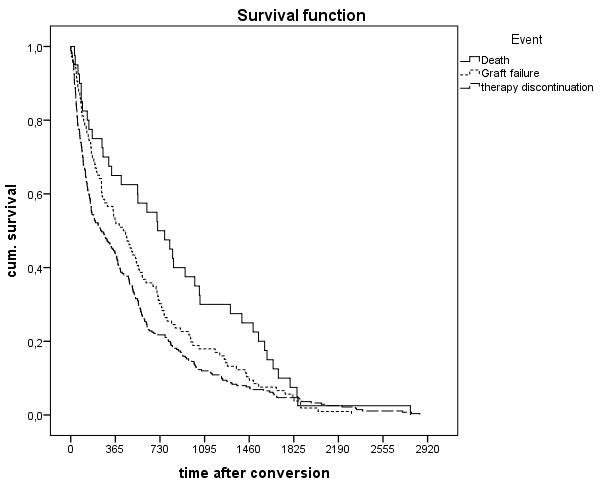Determinants of Successful Use of Sirolimus in Renal Transplantation.
1GSSG, Berlin, Germany
2GSSG, Hannover, Germany
3GSSG, Köln, Germany
4GSSG, Barcelona, Spain
5GSSG, München, Germany
6GSSG, Frankfurt, Germany
7GSSG, Erlangen, Germany
8GSSG, Tübingen, Germany
9GSSG, Heidelberg, Germany
10GSSG - Pfizer, Berlin, Germany
Meeting: 2017 American Transplant Congress
Abstract number: D90
Keywords: Immunosuppression, Kidney transplantation, Proteinuria, Sirolimus (SLR)
Session Information
Session Name: Poster Session D: Kidney Immunosuppression: Novel Regimens and Drug Minimization
Session Type: Poster Session
Date: Tuesday, May 2, 2017
Session Time: 6:00pm-7:00pm
 Presentation Time: 6:00pm-7:00pm
Presentation Time: 6:00pm-7:00pm
Location: Hall D1
Sirolimus (SLR) is an established component in the immunosuppressive treatment after renal transplantation.The side effects of SLR differ from other immunosuppressants and may limit its use.Aim of this retrospective multicenter observational study is to define predictors that allow to determine which patients benefit from a SLR based therapy most likely.All pts from ten German transplant centers who were switched to a SLR containing maintenance immunosuppression three months or later post-transplantation between the years 2000 and 2008 were enrolled (N=726).Observation times after switching to SLR ranged from 4 days to 9 years, with a median time of 24.3 months.Successful use was reported in 304 pts,40 pts died,106 sufferred graft loss and 276 were discontinued from SLR (p=0.008). Most pts discontinued within the first year after SLR initiation (N=157/276).Main reasons for the termination of SLR therapy were a declining graft function and/or a significant increase in proteinuria.At conversion to SLR eGFR was better (45±18 vs. 40±16 vs. 23±10 vs. 39±19ml/min, p<0.001) and proteinuria was less (225±400 vs. 724±1100 vs. 827±953 vs. 587±867mg/l, p<0.001) in pts with successful use of SLR vs death vs graft failure vs discontinued.ROC curve analysis indicated that the optimal cut-offs for successful application of SLR are eGFR of >37ml/min (p<0.001) and proteinuria of <82mg/l (p<0.001).In a multinominal regression analysis successful treated pts showed no difference in age, gender, reason for conversion, year of conversion and time on transplantation at SLR initiation compared to pts with death, graft failure or discontinuation.However Proteinuria showed a negative impact (0.2% per mg/l) and eGFR indicated a positive use (2% per ml/min).Our findings allow to further stratify pts who will benefit most from a SLR therapy.
Most pts discontinued within the first year after SLR initiation (N=157/276).Main reasons for the termination of SLR therapy were a declining graft function and/or a significant increase in proteinuria.At conversion to SLR eGFR was better (45±18 vs. 40±16 vs. 23±10 vs. 39±19ml/min, p<0.001) and proteinuria was less (225±400 vs. 724±1100 vs. 827±953 vs. 587±867mg/l, p<0.001) in pts with successful use of SLR vs death vs graft failure vs discontinued.ROC curve analysis indicated that the optimal cut-offs for successful application of SLR are eGFR of >37ml/min (p<0.001) and proteinuria of <82mg/l (p<0.001).In a multinominal regression analysis successful treated pts showed no difference in age, gender, reason for conversion, year of conversion and time on transplantation at SLR initiation compared to pts with death, graft failure or discontinuation.However Proteinuria showed a negative impact (0.2% per mg/l) and eGFR indicated a positive use (2% per ml/min).Our findings allow to further stratify pts who will benefit most from a SLR therapy.
CITATION INFORMATION: Naik M, Gwinner W, Arns W, Basic E, Budde K, Diekmann F, Fischereder M, Goßmann J, Heller K, Heyne N, Jürgensen J.-S, Morath C, Riester U. Determinants of Successful Use of Sirolimus in Renal Transplantation. Am J Transplant. 2017;17 (suppl 3).
To cite this abstract in AMA style:
Naik M, Gwinner W, Arns W, Basic E, Budde K, Diekmann F, Fischereder M, Goßmann J, Heller K, Heyne N, Jürgensen J-S, Morath C, Riester U. Determinants of Successful Use of Sirolimus in Renal Transplantation. [abstract]. Am J Transplant. 2017; 17 (suppl 3). https://atcmeetingabstracts.com/abstract/determinants-of-successful-use-of-sirolimus-in-renal-transplantation/. Accessed December 17, 2025.« Back to 2017 American Transplant Congress
